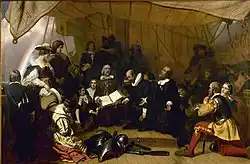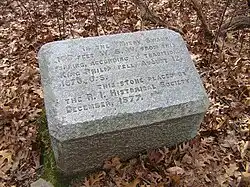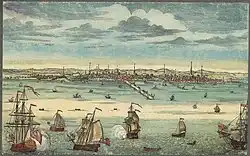King Philip’s War was a conflict that broke out in New England in June 1675 when the followers of Metacomet, a Wampanoag chief known to the European colonists of the region as King Philip, launched a series of attacks against the English settlements in Massachusetts, Connecticut and Rhode Island. These attacks were the result of years of deteriorating relations between the Native Americans of New England and the leaders of the various colonies in Boston and elsewhere. The ensuing war was one of the bloodiest struggles between natives and newcomers in the colonial history of North America. The major period of fighting occurred between the summer of 1675 and the summer of 1676, though some minor clashes continued well into 1677 and it was April 1678 before peace was fully established with the defeat of the Native Americans. Their failure to overthrow the colonial settlements ensured that European settlement would continue here with enormous consequences for the demographic landscape of the region thereafter.[1]
King Philip's War chronology of eventsKing Philip's War chronology of events

King Philip’s War came about after over half a century of English colonial settlement of New England. The first permanent colony was established here at Plymouth following the arrival of the Mayflower there in 1620. It expanded after the foundation of Boston in 1630 and thereafter thousands of settlers came from across the Atlantic Ocean, often leaving England to avoid religious persecution for their overly radical Protestantism back home. The settlers initially managed to maintain cordial relations with the Native Americans of New England, at least trying to respect their land titles to some extent. Tensions eventually began to emerge though as more and more natives were pushed westwards as new colonial groups began expanding into new parts of Massachusetts, Connecticut and Rhode Island. A major sign of this was the Pequot War of 1636 to 1638 between the colonists and the Pequot tribe. The war was a watershed moment in New England’s history, through which the emergence of the colonists as the new political and military power of the region was confirmed.[2]
For decades thereafter the position of the natives continued to deteriorate as they lost more land and thousands of more colonists arrived from Europe. Eventually this would result in a new war, this one much more destructive than the Pequot War. It was initiated by Metacomet, a local chief of the Wampanoags. What was doubly unusual about this was that his family had a history of friendly relations with the colonists in Boston, Plymouth and elsewhere. His father Massasoit had welcomed and provided aid to the first waves of English colonists decades earlier, while Metacomet himself was known to the colonials as King Philip, an Anglicized version of his position as a chief and his name.[3]

Metacomet had organized his followers to launch a series of surprise attacks on English colonial settlements across parts of Connecticut, Rhode Island and Massachusetts simultaneously in mid-June 1675 following the execution of three Wampanoag warriors by the colonists in the Plymouth colony. These initial attacks were just the start of a period of six months of relentless native attacks on colonial settlements, particularly isolated farmsteads and hamlets that were easy targets. Hundreds of colonists were killed in these attacks through to early 1676.[4]
Eventually the colonial community managed to organize a coherent response, gathering together a militia army of hundreds of men armed with modern European guns. Like all colonial powers overseas in early modern times, their success also depended on co-opting the natives and they soon managed to recruit hundreds of other Native Americans from groups who were rivals of the Wampanoags. Together this colonial militia and native army scoured the countryside of New England until they finally managed to hunt down and kill Metacomet in August 1676. By then the war was virtually over, though sporadic outbursts of violence occurred down to 1678 when a peace agreement was reached. By then many of the Wampanoags had been enslaved. Thousands had been killed on both sides, both civilians and soldiers and warriors.[5]
Extent of migration associated with King Philip's WarExtent of migration associated with King Philip's War
In the immediate term King Philip’s War only led to a minor amount of migration, most of it involving Native American groups that had been trying to hold onto their lands in parts of western Massachusetts and Connecticut moving further westwards towards the Great Lakes. This migration continued through the late 1670s, 1680s and 1690s into parts of upstate New York and adjoining regions, often as the natives tried to avoid slavery as a punishment for the war.[6] More broadly, the colonists were now much less inclined to respect land rights, something which they had at least paid lip service to since the 1620s. Owing to their reduced concern for this, colonial settlement continued to accelerate into the late seventeenth and early eighteenth centuries in this part of North America. Perhaps the most esoteric element of the migration associated with King Philip's War concerns several hundreds natives who were enslaved by the New Englanders and sold abroad to remove them from the East Coast of America altogether. Many of these ended up being sent to the Caribbean and sold to the owners of the sugar plantations there. As a result, down to this day, many people on the island of Bermuda affirm that they are the descendants of slaves who ended up here in the late seventeenth century as a consequence of King Philip’s War.[7]
Demographic impact of King Philip's WarDemographic impact of King Philip's War

The foremost demographic impact of King Philip’s War was in the increased settlement of New England and the English colonies in North America more generally from the late 1670s onwards. For instance, in 1670 the colonial population of Massachusetts, fifty years after the arrival of the Mayflower in 1620, stood at around 30,000 people. By 1690 that had reached nearly 50,000, while by 1720 it was 90,000. It would reach around a quarter of a million by the time the American Revolutionary War broke out exactly a hundred years after King Philip’s War. Similar levels of increased colonial settlement were also seen in Connecticut and Rhode Island during this era. Hence, many people living in New England and the East Coast of America today of English, or indeed Scottish, Welsh and Irish descent, may well be able to trace their roots back to an era of expanded settlement here in the late seventeenth century following King Philip’s War.[8]
See alsoSee also
Explore more about King Philips's WarExplore more about King Philips's War
- King Philip's War at World History Encyclopedia
- Colonial Immigrants: Who They Were and Where They Came From at Legacy Family Tree Webinars
- Colonial Immigration – The English Pioneers of Early America at Legacy Family Tree Webinars
- How to Connect with Your Pilgrim Ancestors to Join the Mayflower Society at Legacy Family Tree Webinars
References
- ↑ https://www.worldhistory.org/King_Philip%27s_War/
- ↑ https://www.worldhistory.org/Pequot_War/
- ↑ https://www.history.com/topics/native-american-history/king-philips-war
- ↑ https://www.mayflower400uk.org/education/native-america/2020/july/the-story-of-king-philips-war/
- ↑ https://www.britannica.com/event/King-Philips-War
- ↑ Linford D. Fisher, ‘“Why shall wee have peace to bee made slaves”: Indian Surrenderers During and After King Philip’s War’, in Ethnohistory, Vol. 64, No. 1 (2017), pp. 91–114.
- ↑ https://www.culturalsurvival.org/news/united-through-history-and-experience-wampanoag-bermuda-connections
- ↑ https://web.viu.ca/davies/H320/population.colonies.htm

